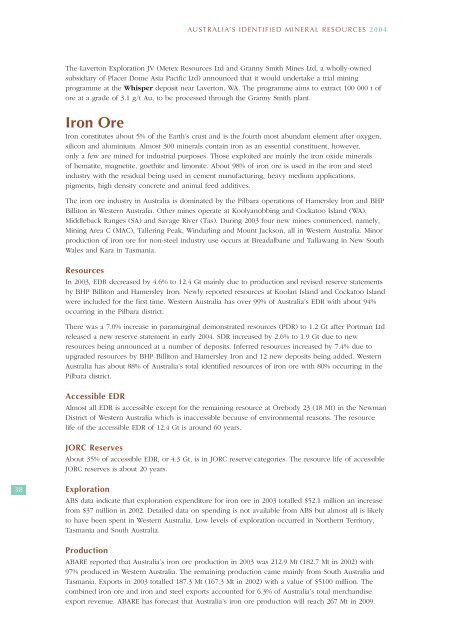australia's identified mineral resources 2004 - Geoscience Australia
australia's identified mineral resources 2004 - Geoscience Australia
australia's identified mineral resources 2004 - Geoscience Australia
You also want an ePaper? Increase the reach of your titles
YUMPU automatically turns print PDFs into web optimized ePapers that Google loves.
AUSTRALIA’S IDENTIFIED MINERAL RESOURCES <strong>2004</strong><br />
The Laverton Exploration JV (Metex Resources Ltd and Granny Smith Mines Ltd, a wholly-owned<br />
subsidiary of Placer Dome Asia Pacific Ltd) announced that it would undertake a trial mining<br />
programme at the Whisper deposit near Laverton, WA. The programme aims to extract 100 000 t of<br />
ore at a grade of 3.1 g/t Au, to be processed through the Granny Smith plant.<br />
Iron Ore<br />
Iron constitutes about 5% of the Earth’s crust and is the fourth most abundant element after oxygen,<br />
silicon and aluminium. Almost 300 <strong>mineral</strong>s contain iron as an essential constituent, however,<br />
only a few are mined for industrial purposes. Those exploited are mainly the iron oxide <strong>mineral</strong>s<br />
of hematite, magnetite, goethite and limonite. About 98% of iron ore is used in the iron and steel<br />
industry with the residual being used in cement manufacturing, heavy medium applications,<br />
pigments, high density concrete and animal feed additives.<br />
The iron ore industry in <strong>Australia</strong> is dominated by the Pilbara operations of Hamersley Iron and BHP<br />
Billiton in Western <strong>Australia</strong>. Other mines operate at Koolyanobbing and Cockatoo Island (WA),<br />
Middleback Ranges (SA) and Savage River (Tas). During 2003 four new mines commenced, namely,<br />
Mining Area C (MAC), Tallering Peak, Windarling and Mount Jackson, all in Western <strong>Australia</strong>. Minor<br />
production of iron ore for non-steel industry use occurs at Breadalbane and Tallawang in New South<br />
Wales and Kara in Tasmania.<br />
Resources<br />
In 2003, EDR decreased by 4.6% to 12.4 Gt mainly due to production and revised reserve statements<br />
by BHP Billiton and Hamersley Iron. Newly reported <strong>resources</strong> at Koolan Island and Cockatoo Island<br />
were included for the first time. Western <strong>Australia</strong> has over 99% of <strong>Australia</strong>’s EDR with about 94%<br />
occurring in the Pilbara district.<br />
There was a 7.0% increase in paramarginal demonstrated <strong>resources</strong> (PDR) to 1.2 Gt after Portman Ltd<br />
released a new reserve statement in early <strong>2004</strong>. SDR increased by 2.6% to 1.9 Gt due to new<br />
<strong>resources</strong> being announced at a number of deposits. Inferred <strong>resources</strong> increased by 7.4% due to<br />
upgraded <strong>resources</strong> by BHP Billiton and Hamersley Iron and 12 new deposits being added. Western<br />
<strong>Australia</strong> has about 88% of <strong>Australia</strong>’s total <strong>identified</strong> <strong>resources</strong> of iron ore with 80% occurring in the<br />
Pilbara district.<br />
Accessible EDR<br />
Almost all EDR is accessible except for the remaining resource at Orebody 23 (18 Mt) in the Newman<br />
District of Western <strong>Australia</strong> which is inaccessible because of environmental reasons. The resource<br />
life of the accessible EDR of 12.4 Gt is around 60 years.<br />
JORC Reserves<br />
About 35% of accessible EDR, or 4.3 Gt, is in JORC reserve categories. The resource life of accessible<br />
JORC reserves is about 20 years.<br />
38<br />
Exploration<br />
ABS data indicate that exploration expenditure for iron ore in 2003 totalled $52.1 million an increase<br />
from $37 million in 2002. Detailed data on spending is not available from ABS but almost all is likely<br />
to have been spent in Western <strong>Australia</strong>. Low levels of exploration occurred in Northern Territory,<br />
Tasmania and South <strong>Australia</strong>.<br />
Production<br />
ABARE reported that <strong>Australia</strong>’s iron ore production in 2003 was 212.9 Mt (182.7 Mt in 2002) with<br />
97% produced in Western <strong>Australia</strong>. The remaining production came mainly from South <strong>Australia</strong> and<br />
Tasmania. Exports in 2003 totalled 187.3 Mt (167.3 Mt in 2002) with a value of $5100 million. The<br />
combined iron ore and iron and steel exports accounted for 6.3% of <strong>Australia</strong>’s total merchandise<br />
export revenue. ABARE has forecast that <strong>Australia</strong>’s iron ore production will reach 267 Mt in 2009.

















